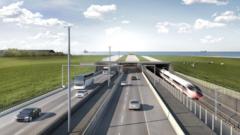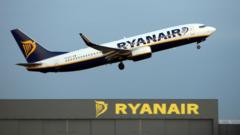Spanning 18km, the Fehmarnbelt tunnel will be the longest pre-fabricated road and rail tunnel globally, drastically reducing travel times and enhancing connections between Scandinavia and central Europe. Amid environmental considerations and engineering marvels, the project promises significant economic benefits for the region.
Record-Breaking Baltic Sea Tunnel to Enhance Europe’s Connectivity

Record-Breaking Baltic Sea Tunnel to Enhance Europe’s Connectivity
The ambitious Fehmarnbelt tunnel project is set to transform travel between Denmark and Germany while promoting greener transport solutions.
A visionary infrastructure project is underway as a record-setting tunnel is being constructed beneath the Baltic Sea to connect Denmark and Germany. The project, known as the Fehmarnbelt tunnel, will stretch 18 kilometers (11 miles) and is designed to be the longest pre-fabricated road and rail tunnel in the world, revolutionizing travel efficiency in the region.
The innovative design entails positioning segments of the tunnel atop the seafloor and uniting them, likened to assembling Lego pieces. The construction site, located on Lolland island's northern coast, encompasses over 500 hectares (1,235 acres). This facility incorporates a harbor and a factory dedicated to manufacturing the tunnel’s massive components, termed "elements."
Henrik Vincentsen, the chief executive of Femern A/S, the state-owned company behind this project, emphasizes the immense scale of the endeavor. Each element will measure 217 meters (712 feet) long and 42 meters wide, utilizing reinforced steel and concrete. Interestingly, unlike conventional underwater tunnels, which typically excavate through bedrock, this project will join 90 individual, pre-fabricated elements submerged like sophisticated building blocks.
Projected to cost around €7.4 billion ($8.1 billion; £6.3 billion), the venture is primarily funded by Denmark, with a contribution of €1.3 billion from the European Commission. This initiative is among the largest infrastructure projects in the area, aligning with a broader EU strategy to enhance transportation links across Europe and encourage reduced air travel.
When completed by 2029, the tunnel will facilitate a car journey from Rødbyhavn in Denmark to Puttgarten in Germany in only 10 minutes and a train ride in seven minutes, thereby replacing the current 45-minute ferry crossing. The new rail route will also shorten travel time between Copenhagen and Hamburg from five hours to just 2.5 hours, thus presenting a more environmentally friendly option for both passengers and freight.
"This project is more than just a connection between Denmark and Germany; it bridges Scandinavia with central Europe," states Vincentsen. He highlights the ecological benefits, asserting that travelers will reduce their carbon footprint significantly by taking this new route.
The construction includes five parallel tubes; two for trains, two for vehicles (each featuring two lanes), and one for maintenance and emergencies. The tunnel structures will be secured with substantial steel doors to guard against the Baltic's waters. The immense sections of the tunnel, each weighing over 73,000 tonnes, will be meticulously positioned with the help of GPS-guided equipment and underwater cameras.
Prof. Per Goltermann from the Technical University of Denmark notes that the decision to build a tunnel was driven by the area's unique geological conditions and safety considerations, favoring a submerged construction approach over a bridge. Plans for a bridge were abandoned, as the threat posed by maritime traffic and extreme weather made tunneling a more prudent choice.
Originally agreed upon in 2008, the project faced delays due to opposition from ferry operators and conservation groups concerned about its ecological impact, particularly on the Baltic's sensitive marine life. However, after legal challenges were resolved, construction gained momentum.
The environmental aspects of the tunnel have not been overlooked. To mitigate ecological disturbance, a 300-hectare wetland area will be developed from the materials dredged during construction. Vincentsen assures that considerable efforts have been made to limit the project’s ecological footprint.
Once operational, the tunnel is expected to accommodate over 100 trains and 12,000 vehicles daily. The revenues from tolls on the new route will contribute to repaying the state-backed loans securing its financing, with projections indicating that repayment will take around four decades.
In addition to easing transportation, the development is anticipated to spur job growth, business opportunities, and enhance tourism in the somewhat underprivileged Lolland region. Locals are eager for the economic revitalization that the project promises, as expressed by senior construction manager Anders Gert Wede, who reminisces about his upbringing in the area. The tunnel, driven by innovation and collaboration, symbolizes a transformative chapter in European infrastructure.




















